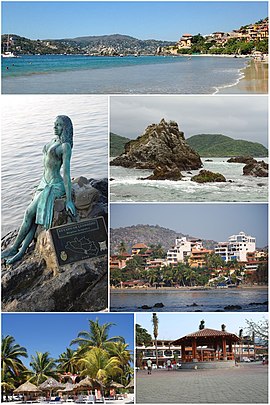Zihuatanejo
Ixtapa-Zihuatanejo | |
|---|---|
| Zihuatanejo de Azueta | |
 Above, from left to right: Panoramic beach 'La Ropa', Statue on the coast that represents Acapulco in Zihuatanejo, Rocks in the bay, Hotels in Playa Madero, Playa Cuachalalate and Playa La Ropa. | |
| Coordinates: 17°38′40″N 101°33′04″W / 17.64444°N 101.55111°W | |
| Country | |
| State | Guerrero |
| Founded | 1520s |
| Municipal Status | 1953 |
| Government | |
| • Municipal President (Mayor) | Jorge Sanchez Allec (2021-2024) |
| Area | |
| • Municipality | 1,468 km2 (567 sq mi) |
| • Town | 10 km2 (4 sq mi) |
| Elevation of seat | 20 m (70 ft) |
| Population (2005) Municipality | |
| • Municipality | 124,609 |
| • Density | 85/km2 (220/sq mi) |
| • Town | 62,376 |
| • Town density | 6,200/km2 (16,000/sq mi) |
| Time zone | UTC−6 (CST) |
| • Summer (DST) | UTC−5 (CDT) |
| Postal code (of seat) | 40880 |
| Area code | 755 |
Zihuatanejo (Spanish pronunciation: [siwataˈnexo]), and/or Ixtapa-Zihuatanejo, is the fourth largest city in the Mexican state of Guerrero. It was known by 18th-century English mariners as Chequetan and/or Seguataneo.[1] Politically the city belongs to the municipality of Zihuatanejo de Azueta in the western part of Guerrero, but both are commonly referred to as Zihuatanejo. It is on the Pacific Coast, about 240 km (150 miles) northwest of Acapulco. Zihuatanejo belongs to a section of the Mexican Pacific Coast known as the Costa Grande.[2] This town has been developed as a tourist attraction along with the modern tourist resort of Ixtapa, 5 km (3.1 mi) away. However, Zihuatanejo has kept its traditional town feel.[3] The town is located on a well-protected bay which is popular with private boat owners during the winter months.[4]
The name Zihuatanejo has two possible origins. One origin might be from the Purépecha language meaning "water of the yellow mountain"; another possible origin might be from Nahuatl (Cihuacan) meaning "place of women."[2][5] Cihuacan, or "place of women", refers to the western paradise of the Nahuatl universe, the home of the "goddess women". According to tradition, these women arose in the afternoon to lead the sun at dusk to the realm of the dead, Mictlan, to give a dim light to the dead.[6] "De Azueta" is in honor of José Azueta, who died fighting a U.S. incursion into the country in Veracruz in 1914.[2]
Zihuatanejo spent most of its history until recently as a fishing village.[2] The federal government's decision to develop the nearby resort in the 1970s has had major implications for both the city and municipality of Zihuatanejo. The area is now the third most-visited area in Mexico, after Cancún and Puerto Vallarta, and the most popular for sports fishermen.[7] Zihuatanejo's population jumped from 6,887 to 37,328 by the early 1990s.[5] Recently, a new highway called the Autopista Siglo XXI was built to connect Zihuatanejo with Morelia, cutting the travel time from Mexico City to about six hours.
Zihuatanejo was notably mentioned in the 1994 film The Shawshank Redemption, in which the protagonist Andy Dufresne (played by Tim Robbins) escapes from prison to Zihuatanejo. Followed by his friend and fellow prisoner, Ellis Boyd "Red" Redding (played by Morgan Freeman) who later joins him. The actual filming location for the film's closing reunion scene was the Sandy Point National Wildlife Refuge on the island of Saint Croix in the US Virgin Islands.
- ^ Walter, Richard, A Voyage Round the World in 1740-4 by George Anson, 5th Edition, London, 1749, pp.259-78 [1]
- ^ a b c d Instituto Nacional para el Federalismo y el Desarrollo Municipal (2005). "Enciclopedia de los Municipios de México Estado De Guerrero Teniente José Azueta" [Encyclopedia of the Municipalities of Mexico State of Guerrero Teniento José Azueta] (in Spanish). Retrieved 14 October 2009.
{{cite web}}: CS1 maint: numeric names: authors list (link) - ^ Juárez Cortés, Eduardo. "Zihuatanejo: Bahia que resguarda yates e historia por igual" [Zihuatanejo:Bay that guards history and yachts equally] (in Spanish). Revista Buen Viaje. Archived from the original on 29 August 2009. Retrieved 14 October 2009.
- ^ "Ixtapa and Zihuatanejo Travel Tips". Los Angeles Times. Los Angeles, California. Retrieved 14 October 2009.
- ^ a b INEGI. "Archivo Historico de las Localidades- Zihuatanejo" [Historical Archive of the Communities- Zihuatanejo] (in Spanish). Mexico: INEGI. Retrieved 14 October 2009.
- ^ "Zihuatanejo Archaeological Museum". Retrieved 14 October 2009.
- ^ Pérez, Elia. "Fin de Semana en Ixtapa-Zihuatanejo" [Weekend in Ixtapa-Zihuatanejo] (in Spanish). Mexico City: Mexico Desconocido. Retrieved 14 October 2009.


